What do Van Gogh’s paintings, the first tweet, and a digital kitten have in common?
They can all exist as NFTs. Once seen as simple pixels on a screen, digital assets are now valuable, tradable, and collectible.
The turning point came when Christie’s sold a digital collage for $69 million, proof that NFTs are not just a passing trend but a new economy. Since then, startups and global brands have rushed into NFT marketplace development, eager to capture this booming market.
In the past, an artist needed a gallery. Today, all they need is an NFT marketplace. Blockchain technology has made digital ownership transparent, secure, and borderless, fueling massive demand for NFT platforms. But behind the buzzword “NFT” lies a complex process.
In this guide, we’ll explain what an NFT marketplace is, how it works, and, most importantly, the real NFT marketplace development cost if you want to build your own platform.
What is an NFT and why it matters in 2025
The first experiments with non-fungible tokens appeared in 2014 and went almost unnoticed.
Today, in 2025, NFTs and NFT marketplaces have become a recognized part of the digital economy and a key driver for businesses exploring NFT marketplace development.
An NFT is a unique digital asset recorded on a blockchain. Unlike Bitcoin or Ether, which are interchangeable, each NFT has its own identity defined by metadata such as ownership history, creation date, and embedded rules. This uniqueness is what makes an NFT platform valuable for creators and collectors.
Most NFTs are minted on Ethereum using standards like ERC-721 or ERC-1155, ensuring that tokens can be traded across wallets, apps, and marketplaces. These standards form the technical foundation for anyone planning to build an NFT marketplace.
What makes NFTs important is provable digital ownership. A JPEG can be copied endlessly, but only one wallet holds the original token proving authenticity.
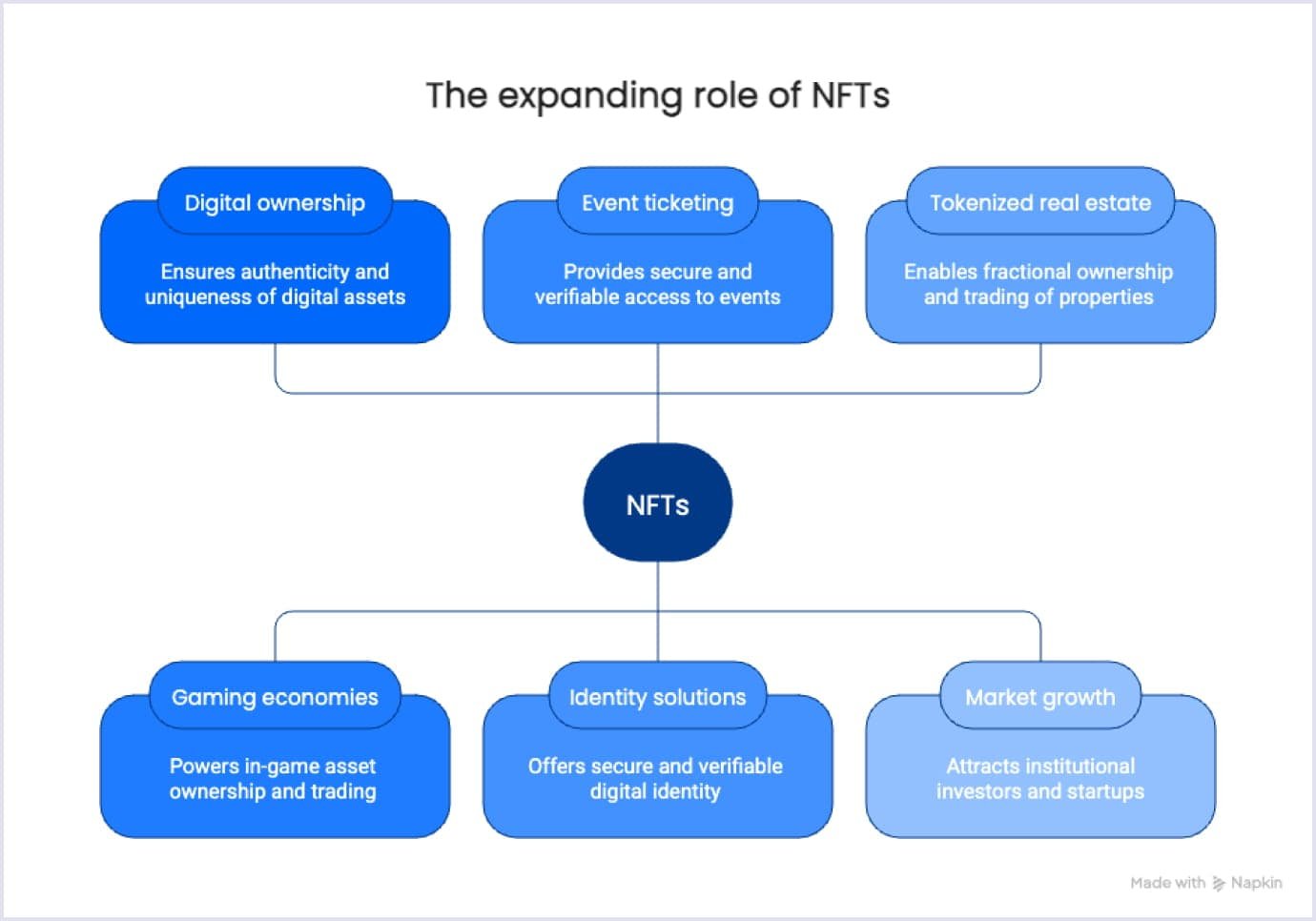
In 2025, this principle powers gaming economies, event ticketing, identity solutions, and even tokenized real estate.
Since 2020, NFT market capitalization has multiplied several times, and the number of active trading wallets continues to grow. What started as a niche hobby is now a sector attracting institutional investors, global brands, and startups eager to estimate NFT marketplace costs and launch their own platforms.

From cryptoKitties to $69M art: The growth of NFT marketplaces
In late 2017, something unexpected happened. A blockchain game called CryptoKitties slowed down the entire Ethereum network. The reason? Thousands of people were breeding, trading, and collecting cartoon cats, each stored as a unique NFT. That playful experiment demonstrated, for the first time, that digital collectibles could ignite massive demand.
Only a few years later, the world saw Beeple’s digital collage “Everydays: The First 5000 Days” sell at Christie’s for $69 million.
That single auction placed NFTs on the global stage, right next to traditional fine art. Around the same time, the NBA launched Top Shot, turning basketball highlights into officially licensed digital collectibles. Within months, the platform generated hundreds of millions of dollars in trades and attracted a mainstream audience.
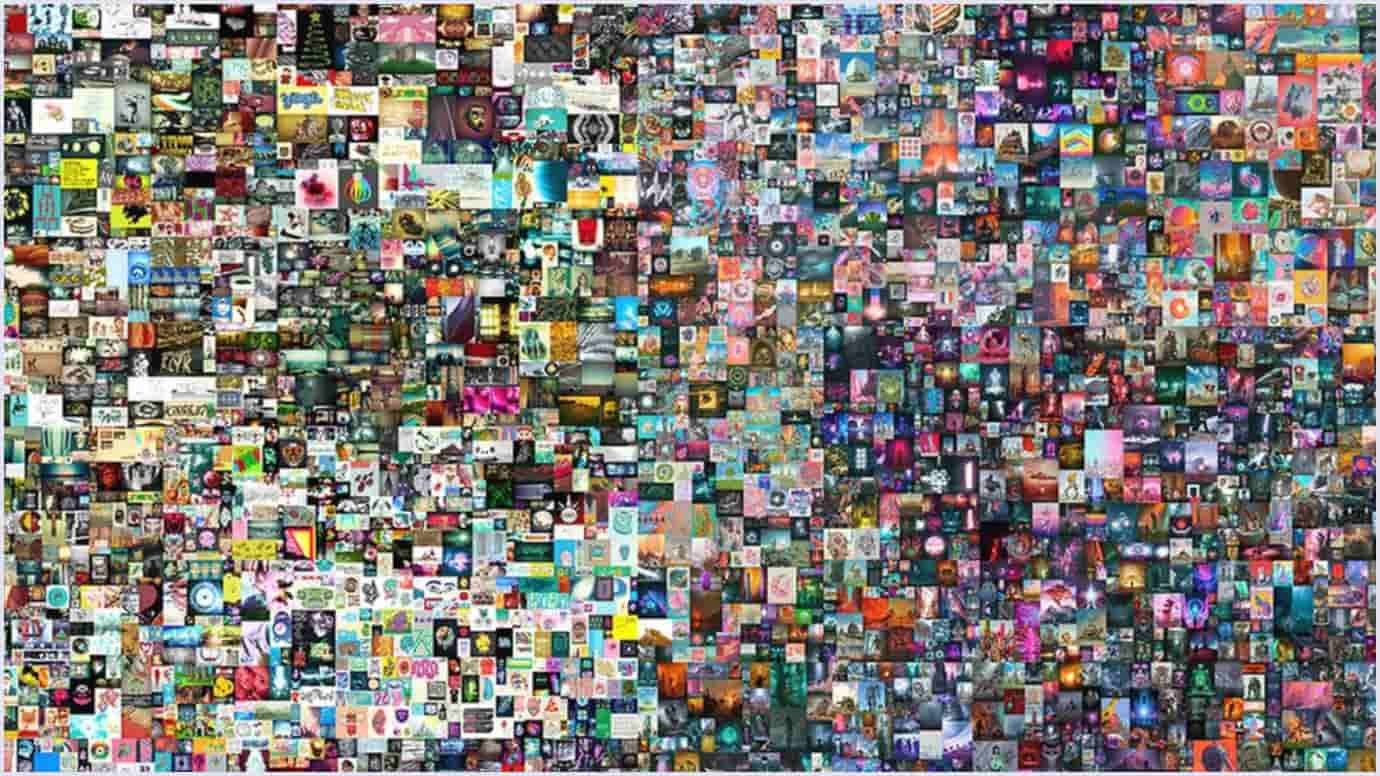
Source: BBC
Let’s take a closer look at some of the best-known NFT marketplaces.
OpenSea
OpenSea is currently the largest and most versatile NFT marketplace. It supports a wide range of assets including digital art, music, domains, virtual land, and in-game items. Thanks to its scale and liquidity, OpenSea often serves as the entry point for both new collectors and professional traders.
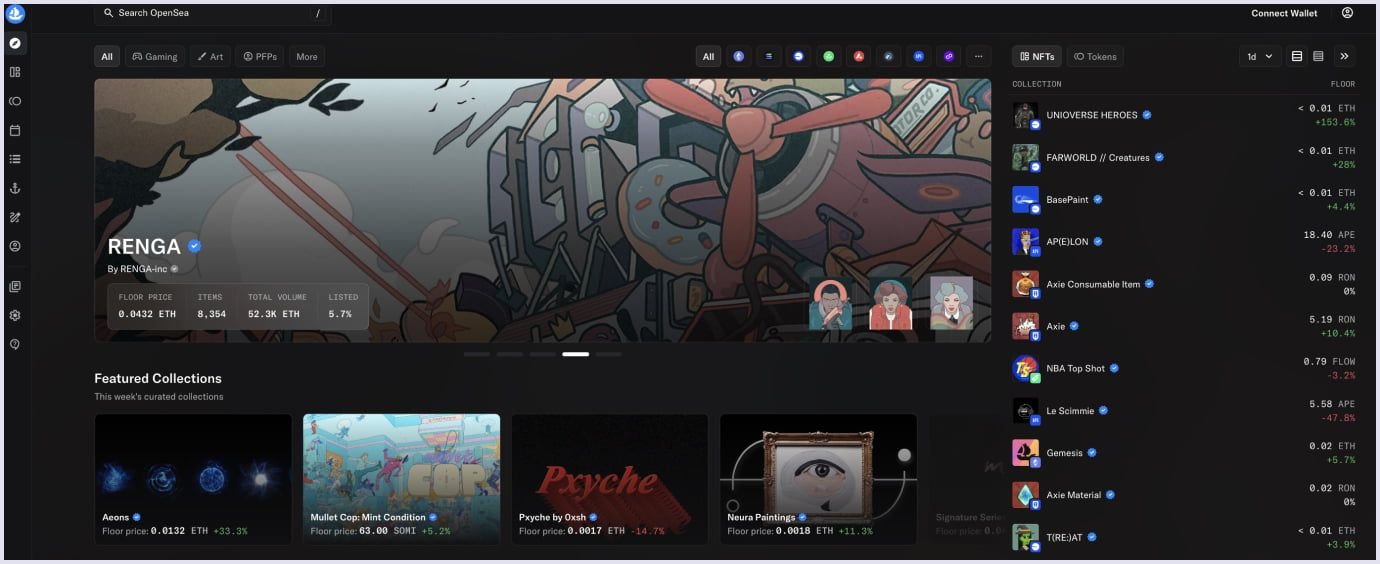
Source: OpenSea
Rarible
Rarible is known for being community-driven and operates with its own governance token, RARI. The platform allows creators to mint and sell NFTs without strict curation, making it more open and diverse. Over time, Rarible has become a hub for digital artists looking for flexibility and community involvement.
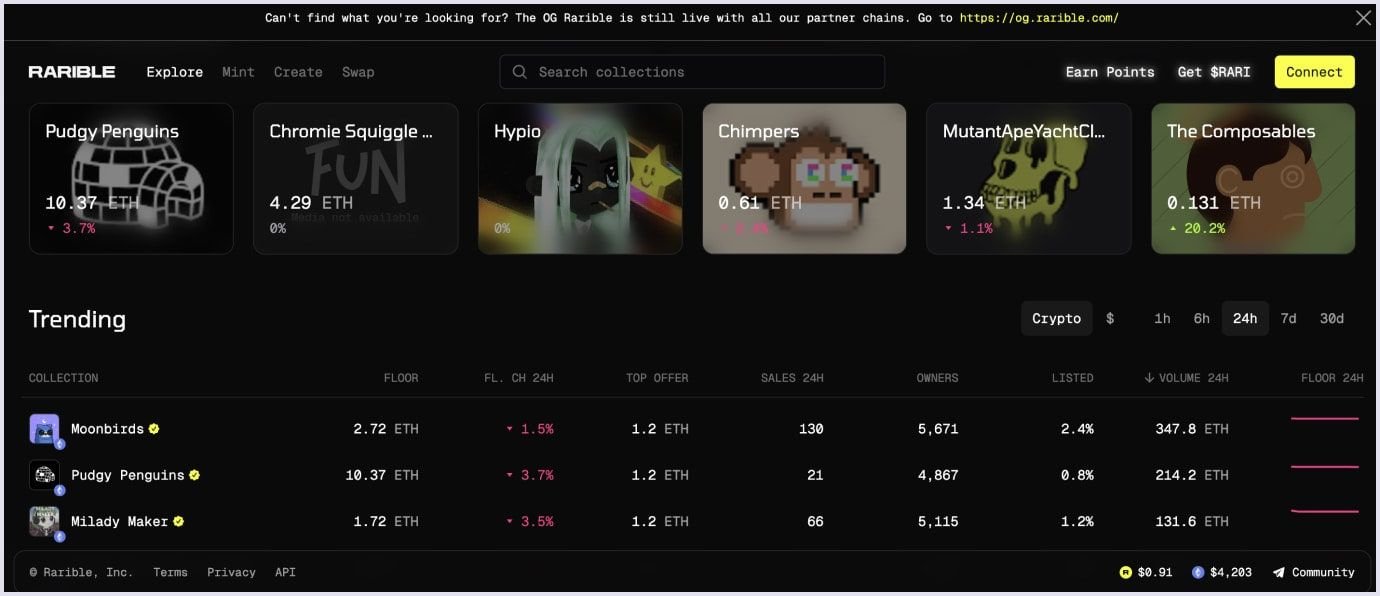
Source: Rarible
SuperRare
SuperRare takes a different approach by focusing on exclusivity and curation. Only selected artists can mint NFTs on the platform, which ensures high-quality works and a gallery-like feel. As a result, SuperRare attracts serious collectors who are searching for scarce and premium digital art.
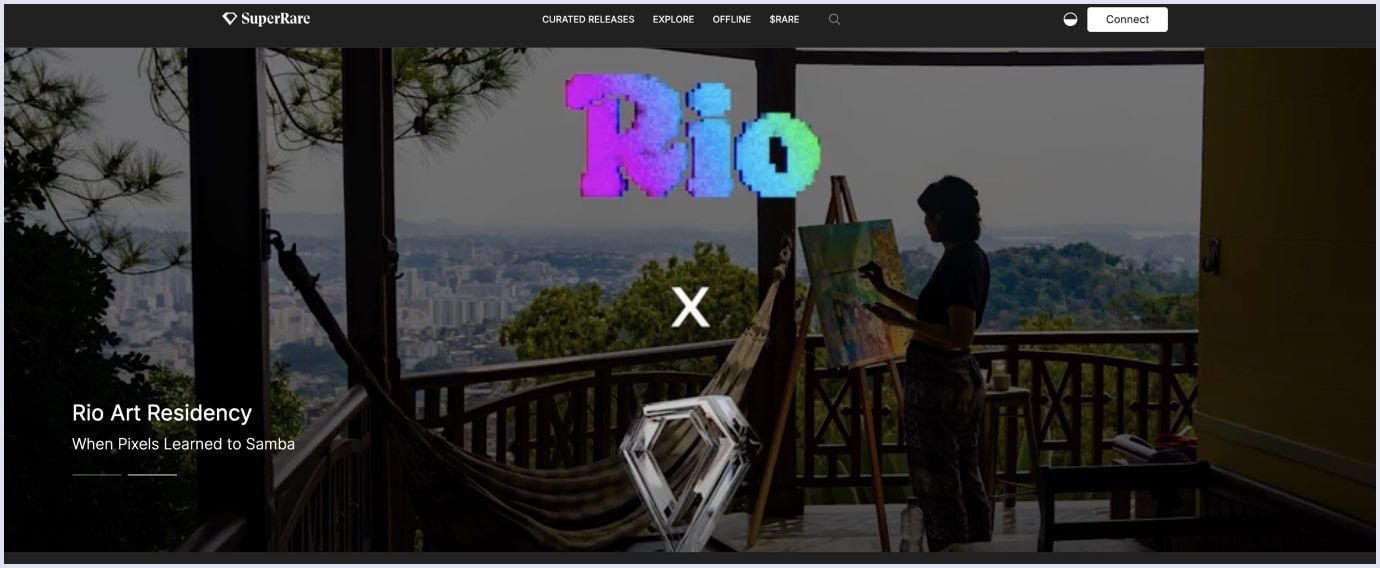
Source: SuperRare
Decentraland Marketplace
Decentraland Marketplace is the official platform for trading virtual land, wearables, and other in-game assets within the Decentraland metaverse. Each item is represented as an NFT on the Ethereum blockchain, ensuring provable ownership and scarcity. The marketplace plays a central role in the virtual economy, where users buy, sell, and build digital real estate and experiences.
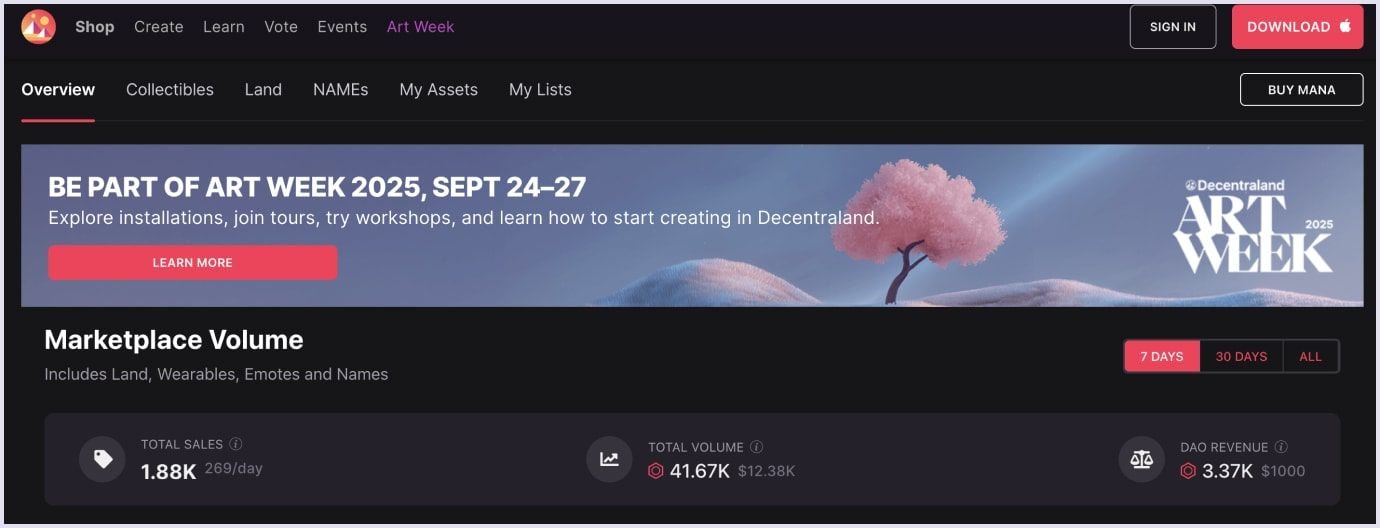
Source: Decentraland Marketplace
NBA Top Shot
NBA Top Shot brings sports fandom into the NFT space by turning basketball highlights into tradable collectibles. Its official licensing from the NBA and NBPA adds credibility and mass appeal. With millions in transaction volume, Top Shot has introduced NFTs to a mainstream audience that might never have touched crypto otherwise.
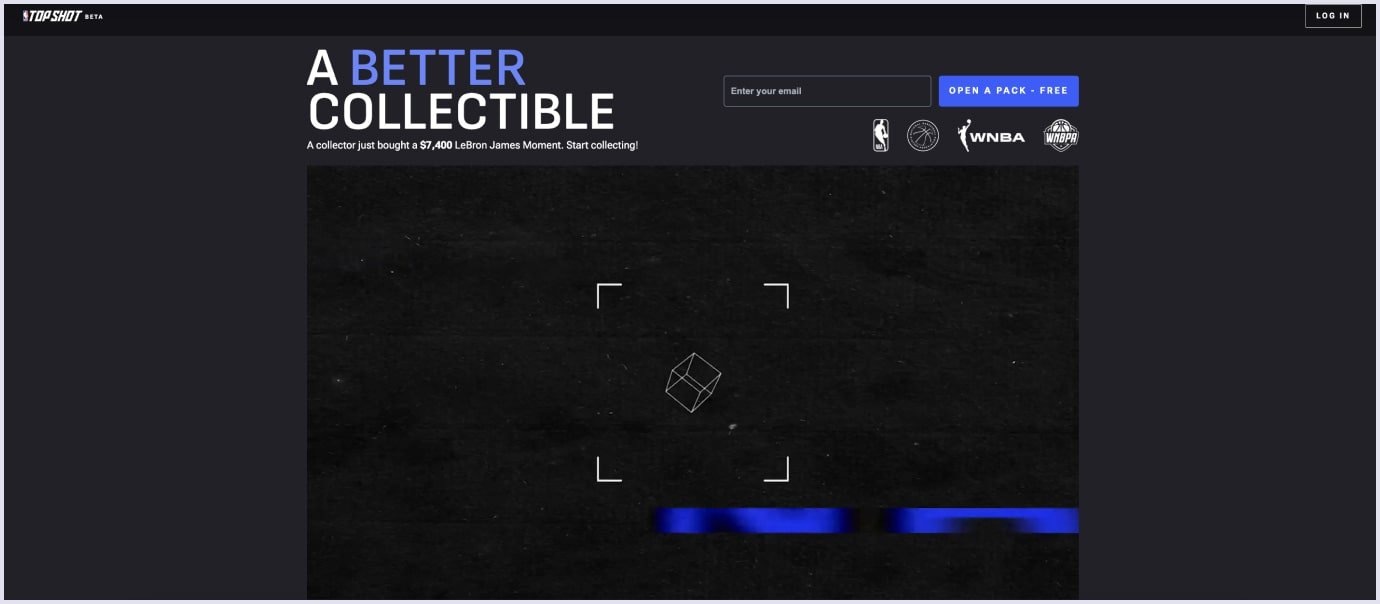
Source: NBA Top Shot
By 2020, the value of NFT transactions had already surpassed $250 million, and marketplaces like these became central hubs for trading.
Today, they are more than storefronts. They’ve evolved into cultural stages where new asset types emerge, tweets, memes, music files, virtual land, you name it. Each cycle of innovation broadens what people consider worth collecting, and every marketplace acts as a gateway into this expanding universe.
How NFT marketplaces work: Smart contracts and user flow explained
NFT marketplaces are powered by smart contracts. Self-executing agreements written in code. Instead of a middleman holding funds or verifying authenticity, the blockchain does it automatically.
Here’s how it usually plays out for a user. First, they connect a crypto wallet, MetaMask, Coinbase Wallet, or another provider. This wallet is also a digital identity. Next, they create or “mint” an NFT by uploading a file and adding metadata like title, description, and properties. The smart contract then generates the token on the blockchain.
To make it clear, the typical user flow looks like this:
- Register an account on the platform;
- Connect a crypto wallet;
- Mint an NFT by uploading a digital item;
- Add metadata such as title, description, and attributes;
- List the item for sale (fixed price or auction);
- Wait for moderation or verification (depends on platform rules);
Complete the sale - the smart contract transfers both payment and ownership instantly. Once listed, the NFT can be sold in two main ways: at a fixed price or through an auction. If someone decides to buy, the smart contract executes the deal instantly. Payment (usually in cryptocurrency like ETH) is transferred to the seller, and ownership of the token is transferred to the buyer. No escrow agents, no manual approvals. Just code.
Moderation systems vary: some platforms verify items before publishing, others allow instant listing but highlight verified creators with badges. Either way, transparency is guaranteed because the blockchain records every transaction.
Behind the scenes, token standards define functionality. ERC-721 ensures each NFT is one-of-a-kind. ERC-1155 brings efficiency by allowing creators to mint both unique and semi-fungible tokens in bulk. These standards enable interoperability, letting NFTs move across apps and marketplaces without friction.
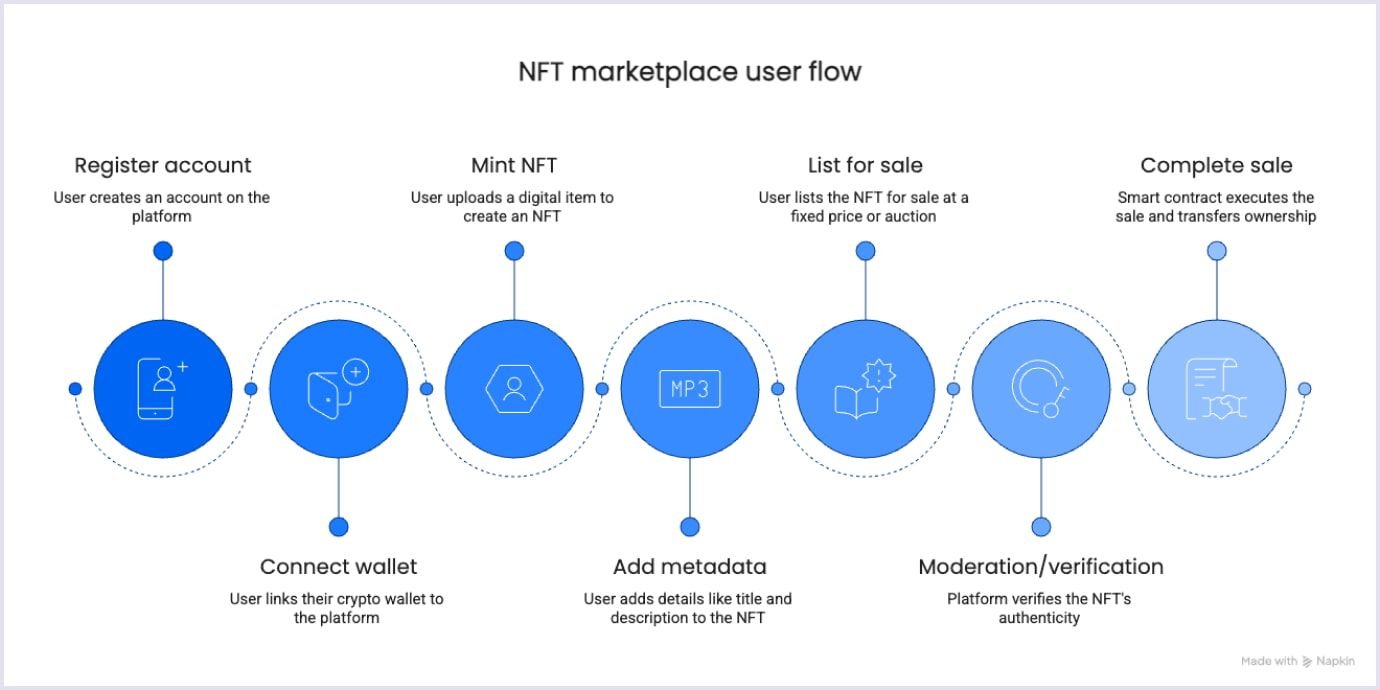
What makes this flow so powerful is its simplicity for the user and its reliability for the market.
The steps are straightforward, register, connect a wallet, mint, list, trade, yet underneath, complex cryptography and smart contracts ensure authenticity, scarcity, and secure transfers.

Key features every successful NFT marketplace must include
It’s tempting to think an NFT marketplace is just a catalog with a “buy” button. In reality, the success of the platform depends on a set of carefully crafted features. Miss one of them, and users simply won’t stay.
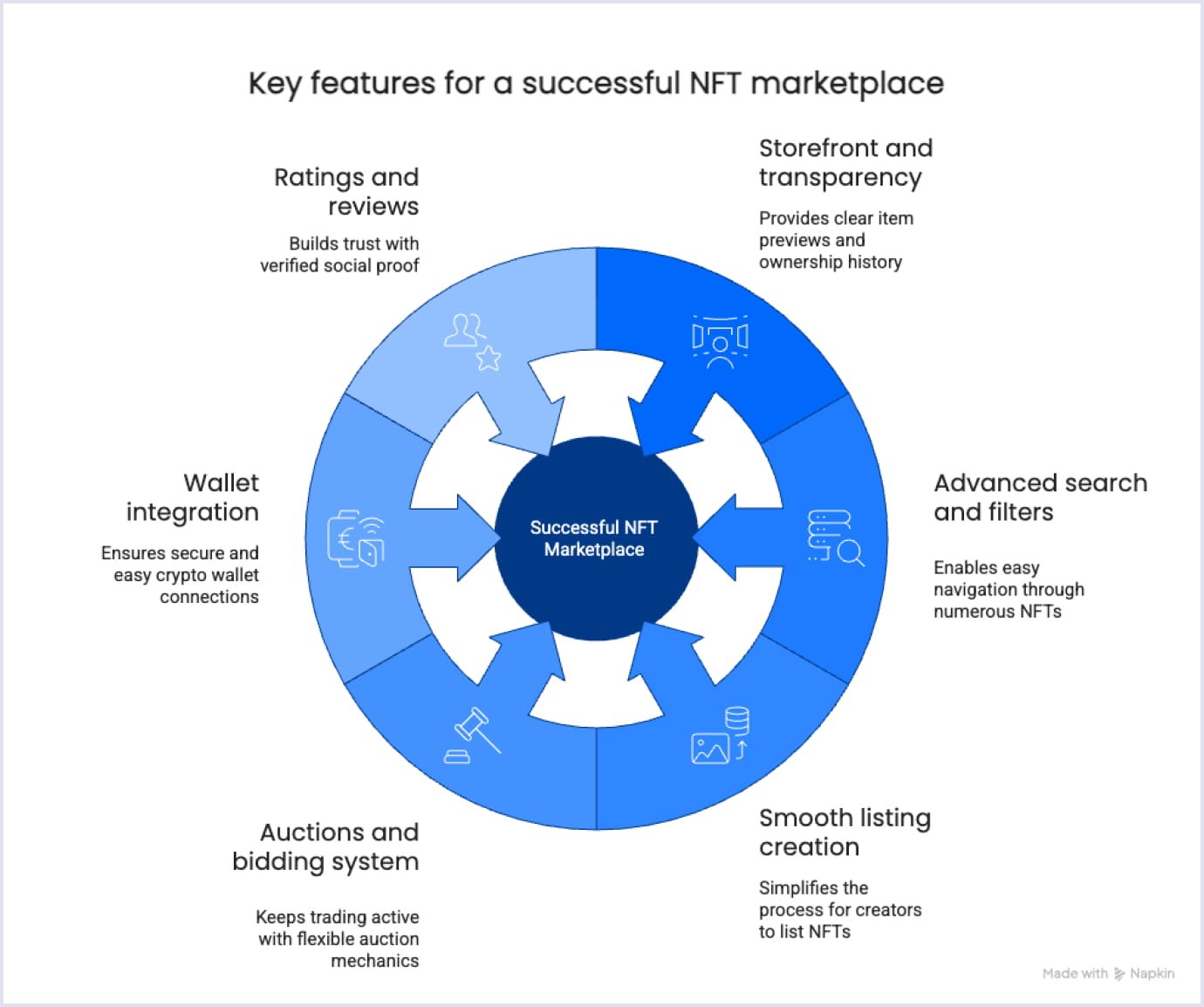
Storefront and transparency
Every marketplace needs a clear storefront where buyers see item previews, prices, bids, and ownership history. Transparency is what gives trust to a market built on scarcity.
Advanced search and filters
When thousands of NFTs are listed daily, chaos is the enemy. Effective filters (by category, price, popularity, creator) and search make navigation painless. The faster a buyer finds what they want, the higher the chance they’ll actually purchase.
Smooth listing creation
For creators, minting and listing must feel simple. Upload the file, add metadata, set royalties, done. If the process takes too long or feels complicated, the marketplace loses talent.
Auctions and bidding system
Some NFTs sell instantly, others thrive in bidding wars. Flexible auction mechanics with expiration dates and watchlists keep trading active and exciting.
Wallet integration
Without crypto wallets, marketplaces don’t exist. MetaMask, Coinbase Wallet, WalletConnect. The more integrations, the better. Security and ease of use must be balanced here.
Ratings and reviews
Social proof matters. Verified reviews and ratings help newcomers trust sellers and discover reliable creators.
NFT marketplace development: Ready-made tools vs. custom solutions
Here’s a hard truth: there’s no single way to develop an NFT marketplace. Businesses usually choose between ready-made frameworks and full custom development.
- Ready-made tools (like OpenSea SDK or white-label solutions) offer speed and a lower upfront cost. You get pre-built infrastructure and can launch within weeks. But there’s a catch: customization is limited, scaling becomes difficult, and relying on third-party infrastructure can restrict long-term growth. For a proof of concept, that might work. For a business, it’s often a dead end.
- Custom development, on the other hand, means building the marketplace from the ground up - architecture, smart contracts, user flows, integrations, and security, all aligned with your business model. Yes, it requires more investment and time, but the payoff is freedom: you own the code, you decide the features, you scale when and how you want.
A ready-made tool is like renting an apartment. Quick move-in, lower cost, but your ability to remodel is limited, and the property is never truly yours. Custom development is building your own house. Slower at first, but it’s fully yours, and you decide how big it can grow, what it looks like, and how strong its foundation will be.
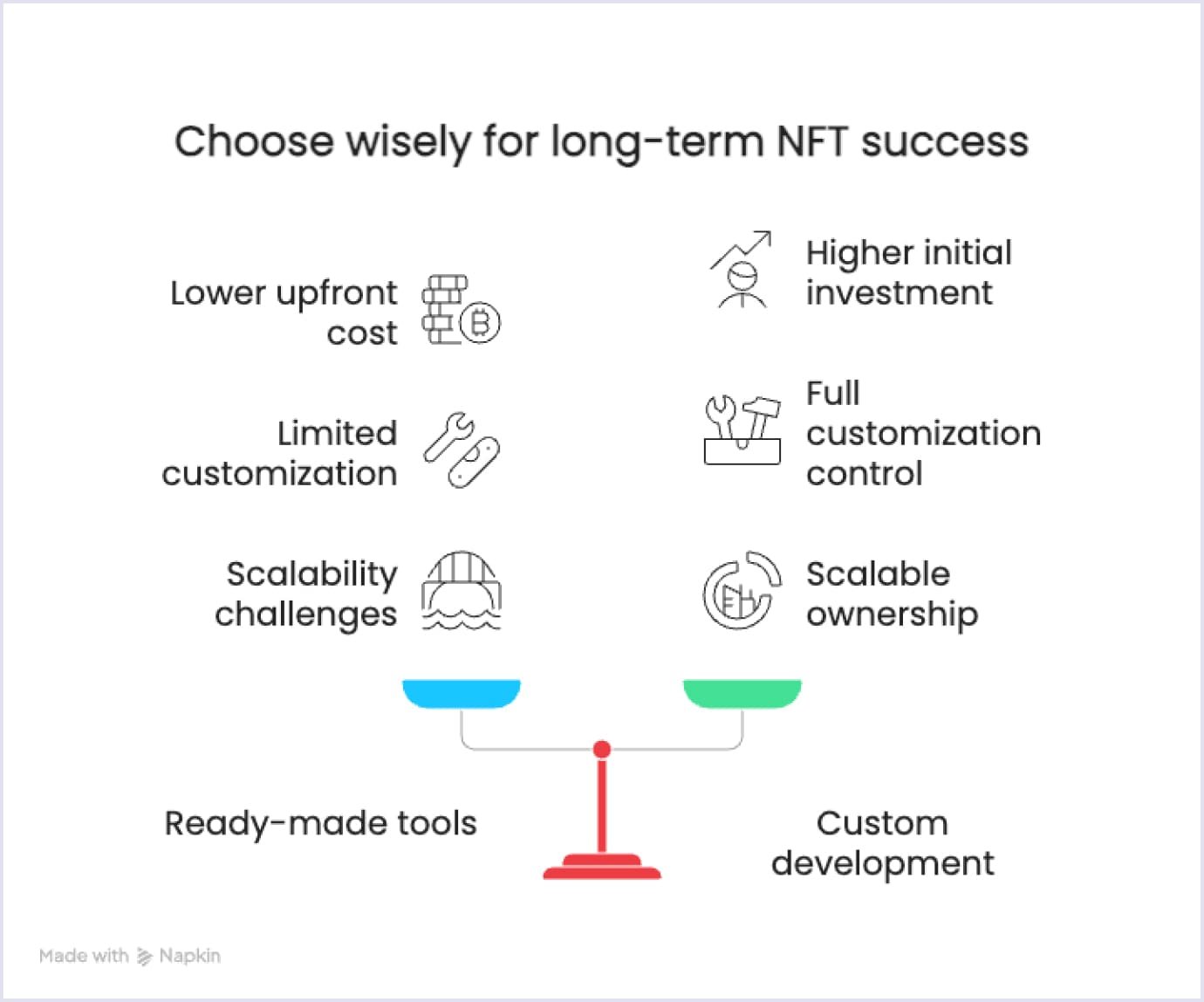
In a market where trust, uniqueness, and scalability define success, custom NFT marketplace development is the safer bet for any company planning to build long-term value.
NFT marketplace development cost: Full breakdown and estimates
So, how much does it actually cost to build an NFT marketplace? The short answer: it depends. The long answer: every feature, integration, and design choice influences the budget. Let’s break down typical cost components (assuming an average $50/hour development rate):
| NFT marketplace development cost | ||
| Features | Time, hours | Cost ($50/h) |
| Design | ||
| UX development | 42 | $2,100 |
| UI development | 64 | $3,200 |
| Architecture | ||
| Project setup | 16 | $800 |
| DB structure | 32 | $1,600 |
| Integrations | ||
| Payment (Stripe or PayPal) | 64 | $3,200 |
| Main functionality | ||
| Authorization and security | 72 | $3,600 |
| User Profiles | 42 | $2,100 |
| Homepage | 84 | $4,200 |
| Search and filters | 96 | $4,800 |
| Product page | 42 | $2,100 |
| Reviews and ratings | 48 | $2,400 |
| Shopping cart | 48 | $2,400 |
| Payments | 42 | $2,100 |
| Notifications | 32 | $1,600 |
| Etherium integration | 92 | $4,600 |
| NFT management | 92 | $4,600 |
| Inventory management | 92 | $4,600 |
| Buyer panel | 64 | $3,200 |
| Author panel | 80 | $4,000 |
| Admin panel | 92 | $4,600 |
| Non-development activity | ||
| Project management | 64 | $3,200 |
| Quality assurance | 80 | $4,000 |
| Code review | 48 | $2,400 |
| Total | 1428 | $71,400 |
In total, building a mid-level NFT marketplace usually starts at around $70,000–80,000. Complex, large-scale platforms with custom features and enterprise-level security can cost significantly more.

How can Codica help with NFT marketplace development?
Since 2015, Codica has been building custom marketplaces and complex web platforms.
Over the years, the team has delivered 100+ successful projects for startups and enterprises worldwide. With 10+ years of experience in software development, Codica has grown into a trusted partner for companies looking to launch products that are reliable, scalable, and user-focused.
When it comes to NFT and blockchain-related projects, Codica’s priorities are clear:
- Security, integrating blockchain solutions and protecting sensitive data with advanced encryption.
- Scalability, using a modern tech stack so platforms can grow without limits.
- User experience, combining intuitive design with powerful functionality to attract and retain users.
One of Codica’s notable projects involved integrating blockchain APIs for a fintech startup, enabling ultra-secure storage and transaction processing. It reflects the company’s philosophy: robust architecture first, innovation second.
But technology is only part of the story. Codica’s strength lies in its team of professionals - developers, designers, and project managers who understand both product strategy and technical execution. That’s why businesses that come to Codica don’t just get code. They get guidance on features, monetization models, compliance, and long-term scaling.
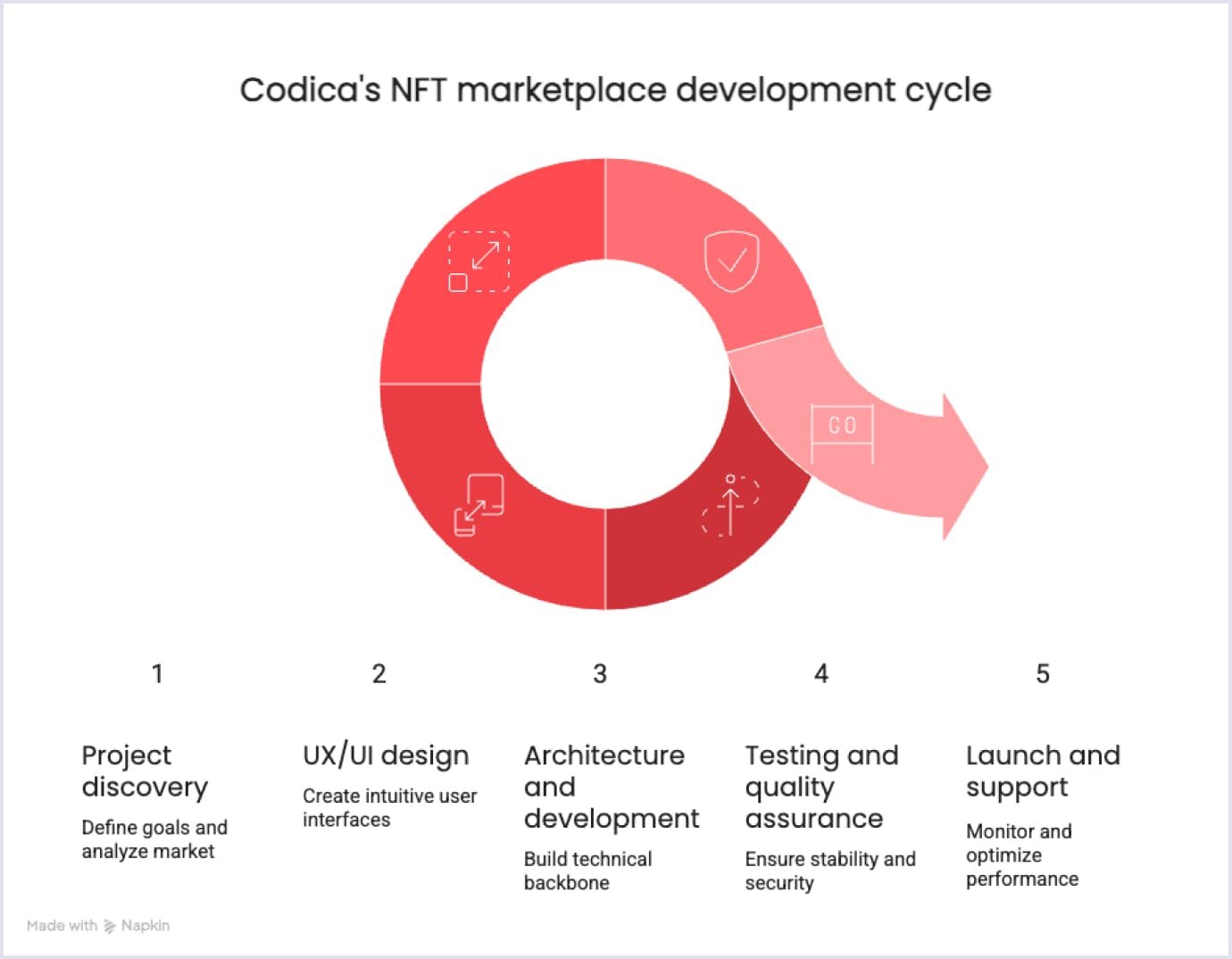
Step 1. Project discovery
Every marketplace starts with clear goals. At this stage, Codica runs a project discovery session to define the business vision, analyze competitors, identify the target audience, and outline must-have features. By offering product discovery services, we help reduce risks, prioritize functionality, and give the project a solid foundation for development.
Step 2. UX/UI design
At this stage, Codica provides professional UI/UX design services, creating wireframes and prototypes that match both business goals and user expectations. The result is a marketplace where creators and buyers interact intuitively, leading to fewer drop-offs and more transactions.
Step 3. Architecture and development
Here, the technical backbone is built: database structure, integrations, APIs, and blockchain components. As part of our online marketplace development services, Codica also delivers smart contracts to manage NFT minting, trading, and ownership transfers securely. The result is a scalable architecture designed for long-term growth.
Step 4. Testing and quality assurance
No marketplace can afford downtime or transaction errors. That’s why Codica provides end-to-end quality assurance services, running unit tests, security audits, and load testing at every stage of development. This approach ensures the platform remains stable and secure even under heavy traffic.
Step 5. Launch and support
After deployment, Codica continues to monitor, optimize, and scale your platform. Post-launch support covers bug fixes, feature updates, and performance improvements so the marketplace can grow with user demand.
Should you build an NFT marketplace in 2025? Final thoughts
Every NFT marketplace starts as an idea. Some stay just that, ideas. Others grow into platforms with millions in trade volume. The difference lies in execution, technology, and the right team behind the product.
In 2025, launching an NFT marketplace makes sense if you follow several key principles:
- Clear niche strategy. Instead of trying to compete with global giants as a “general-purpose” marketplace, focus on a domain where you can dominate, gaming, real estate tokenization, fine art with unique functionality, or branded collections.
- Added value, not duplication. Success requires solving a concrete problem, not just offering a prettier version of OpenSea. Examples include cross-chain listings, integration with physical goods, licensing solutions, rights management, or advanced royalty mechanisms.
- Long-term focus. Quick profit is no longer the driving force. Investors and users alike expect a strong foundation, technological differentiation, and a vision for sustainable growth.
- Regulatory adaptability. Choose jurisdictions with clear rules or build your platform flexibly enough to adjust to evolving compliance requirements.
- Community and marketing. Growth depends not only on features but also on your ability to attract and retain creators, users, and projects. Building an engaged community is as important as building secure technology.
At Codica, we apply over ten years of marketplace development skill and blockchain expertise to turn concepts into enduring solutions.
View our portfolio to see how we transform concepts into products. Your vision could be next: talk to us today.

